Sarson ka saag is a classic winter staple from North India. It’s made with a mixture of fresh greens (especially mustard greens) and tempered with onion, and garlic in ghee. This saag is topped with white butter and served with makki ki roti and sides (jaggery, sliced onions, pickle).
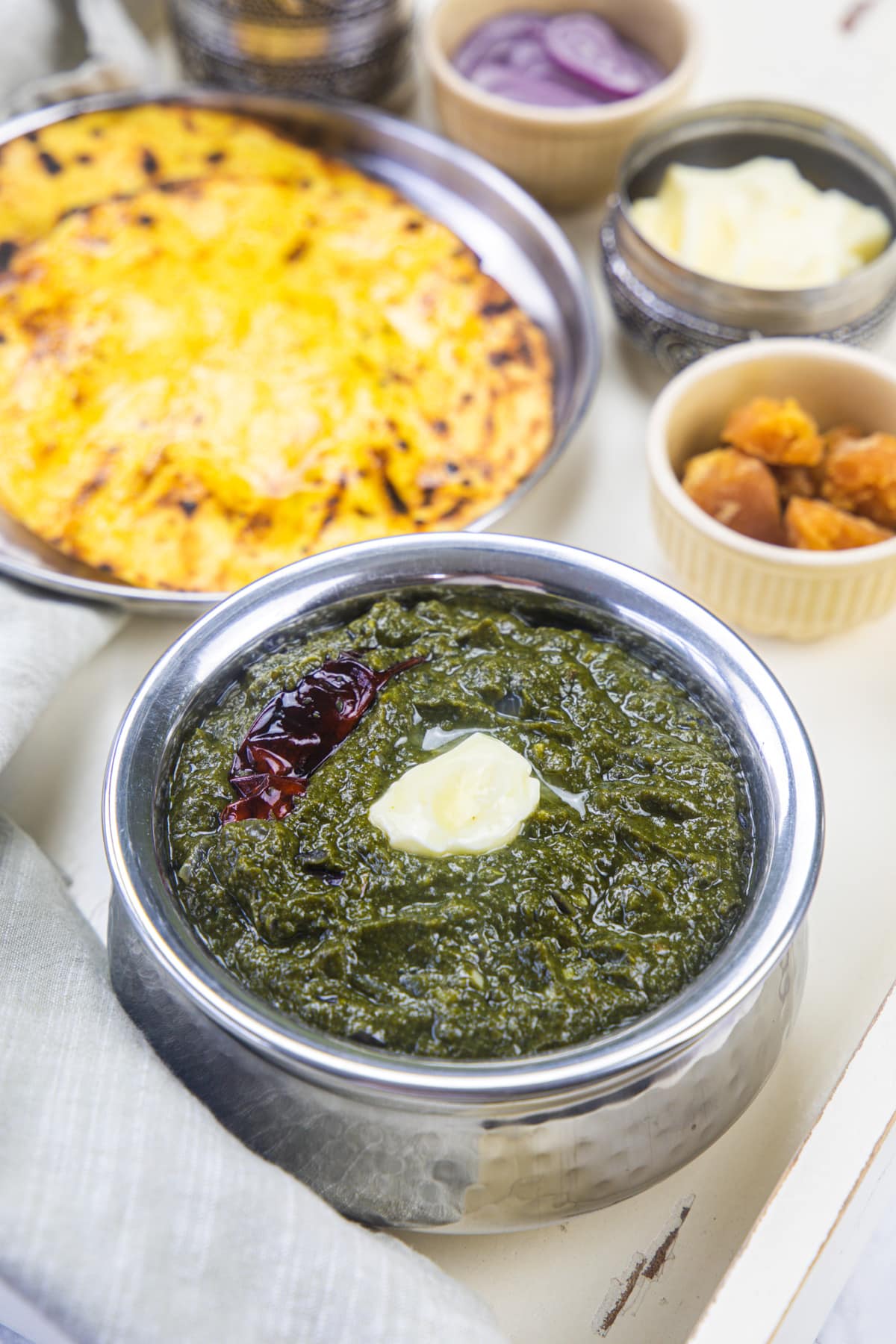
Jump to:
What Is Sarson Ka Saag?
Sarson = Mustard leaves
Saag = A generic term for leafy greens.
As the name says sarson ka saag, this dish is made from mustard greens. But mustard leaves are so pungent and bitter in taste. So to mallow down its flavor other greens are added like bathua, spinach (palak), hare chane ka saag, mooli leaves, fenugreek leaves, etc.
Every family in North India has their version of making sarson ka saag as the recipe varies in proportion or types of greens used here. Also, some add mooli (white radish) or shalgam (turnip).
- Taste: It has mild flavors (as no spice powders are added) and the flavor of greens shines here. It is slightly pungent yet creamy and delicious.
- Texture: Coarse gravy texture (though you can puree into smooth) with a slight creaminess.
How Sarson Ka Saag Is Made Traditionally?
- Traditionally, it is made in a clay pot (mitti ki handi).
- Leafy greens are finely chopped and slow-cooked along with water until tender.
- Then cooked greens are mashed with madani (a wooden churner) until it reaches a coarse gravy texture.
You’ll Love My Sarson Ka Saag Recipe
- Quick: Instead of slow cooking, we are cooking the greens in a pressure cooker (Instant pot).
- Easy to make: Instead of hand mashing, we are using a hand blender.
- Scalable: You can double, or triple the amount and make a large batch.
- Freezer-friendly: After making a large batch, freeze them in portions (based on your serving sizes) and you’ll have a meal ready for later days.
🧾 Ingredient Notes
The below ingredients are cooked in the pressure cooker (instant pot).
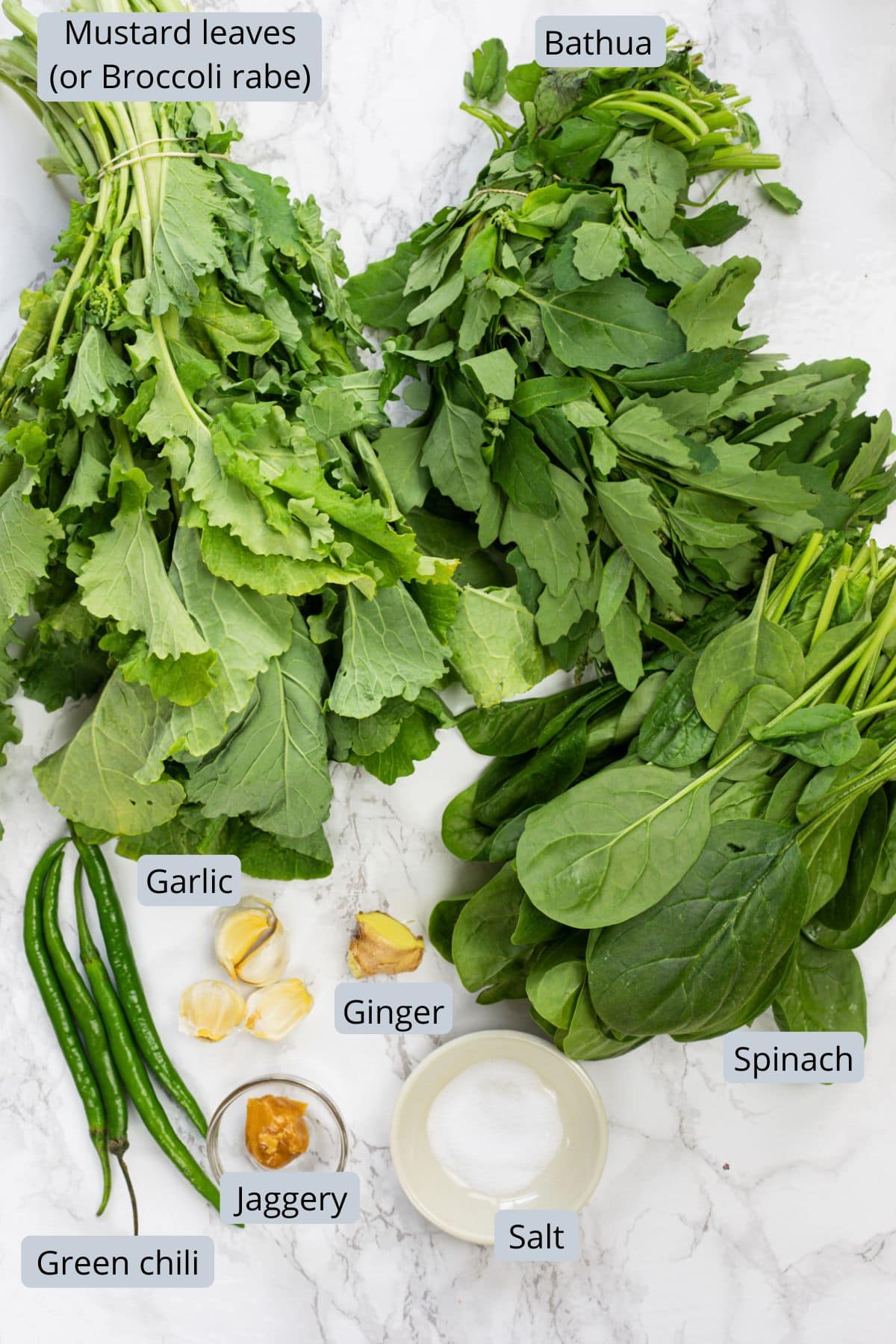
- Sarson (Mustard leaves): Here in the USA in Indian grocery stores, we get real Indian mustard leaves occasionally (when in season). Otherwise, they sell broccoli rabe (rapini) saying mustard greens. These two are almost similar in taste so we can use broccoli rabe instead of mustard leaves.
- Bathua: A few years ago, I have never seen bathua in Indian grocery stores. But in recent years, I find bathua during the winter months. If you can’t find this greens then you can use any other greens like collard greens, or turnip greens, or simply use more spinach.
- Spinach (Palak): Do not use baby spinach as it is delicate and becomes bland after pressure cooking. So always use regular spinach leaves.
- The ratio of greens for sarson ka saag:
- Typically 1:1 ratio of mustard greens to other leafy greens are used for making the best-tasting saag.
- So, here I have used 500 grams of mustard greens and 500 grams of rest leafy greens (250 grams bathua and 250 grams spinach).
- If you’re using more than two other leafy greens then keep the spinach amount 250 grams as it is. The remaining 250 grams can be a mixture of bathua, mooli leaves, turnip leaves, or methi, etc.
- If you are in the Northern part of India and you get your hands on hare chane ka saag then I highly recommend using it. This green is slightly sweeter in taste that balances the bitter, pungent flavor of mustard greens. If using this hare chane ka saag then skip the jaggery in the recipe.
- Ginger, Garlic: chop them roughly into chunks and use. No need to chop them finely.
- Green chilies: This is the only ingredient that adds a spicy taste to this saag. So adjust the amount as per your liking. I have used long Indian green chilies which are medium spicy. If you prefer spicy then use tiny Thai green chilies.
- Jaggery: It is used to balance the bitter and pungent flavor of mustard leaves.
Below is the pic of the ingredients you’ll need to add to cooked saag and for tempering.
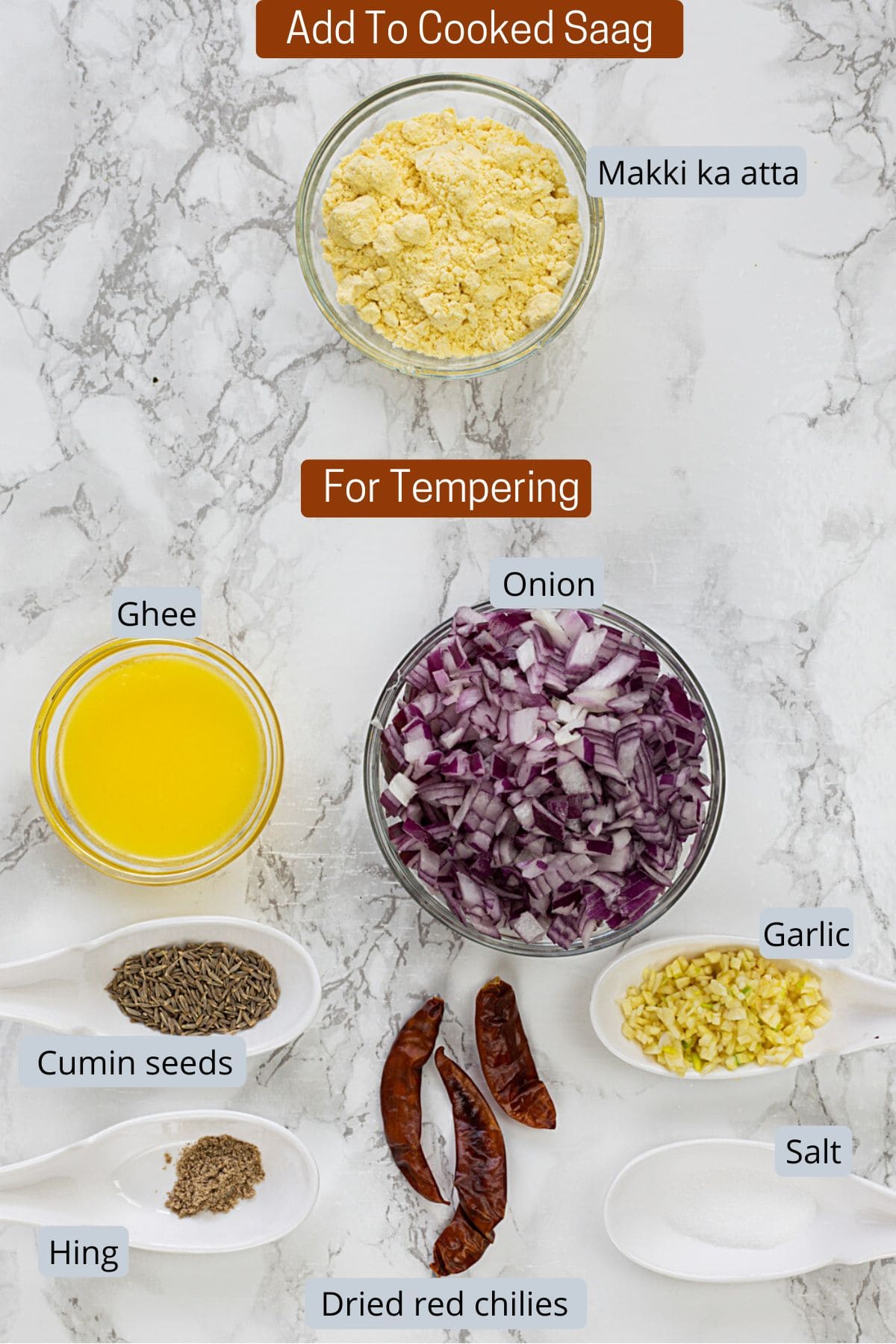
- Makki ka atta: It is added to the cooked saag and it helps to thicken the sarson ka saag. Plus, it adds a slightly creamy texture.
- Ghee: Highly recommend using ghee as it enhances the taste and flavor of Punjabi saag. To make it vegan, you can simply use oil.
- Garlic: Finely chopped or minced garlic is used for tempering.
- Onion: For Indian cooking, I prefer red onion.
👩🍳 How To Make Sarson Ka Saag Recipe? (Pics)
Preparing Greens:
1) Remove and discard the tough stems of mustard leaves and keep the leaves in a large bowl of water for around 5-10 minutes and let the dirt, and sand settle at the bottom of the bowl. Then gently without disturbing the water too much remove the leaves, lightly squeeze out the water and chop them roughly. Because we are pressure cooking, no need to chop them finely.
Similarly, clean the spinach and bathua. Amongst all the greens, bathua will have the maximum amount of dirt sticking to the leaves. So you have to do this cleaning process 2-3 times until the leaves look clean.
2) No need to chop spinach and bathua leaves.
Also, chop the ginger, garlic and green chili into big chunks. Do not chop them finely otherwise pressure cooking makes them flavorless.
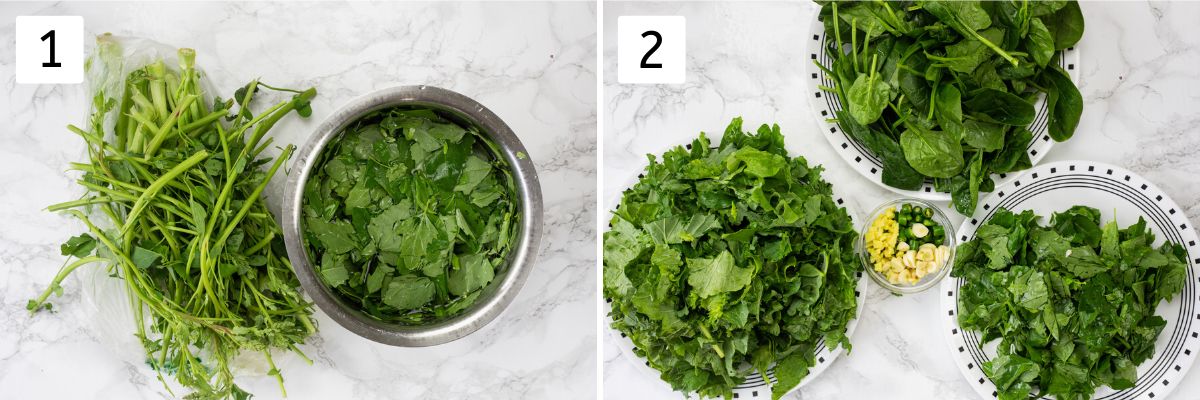
Making Punjabi Saag:
1) Take all the greens (mustard leaves, spinach, bathua), chopped ginger, garlic, green chili, salt, and jaggery in a pressure cooker (or instant pot liner). Add water and cover it with a lid.
2) Instant pot: Keep the valve to the sealing position and cook on manual (high pressure) for 5 minutes. Let the pressure release naturally and wait for the pin to drop.
Stovetop pressure cooker: Cook on medium heat for 2 whistles and let the pressure go down by itself.
3) Once the pressure is released open the lid.
4) Now using a hand blender, crush them roughly into a coarse texture gravy. If you want then you can make a smooth puree in a blender.
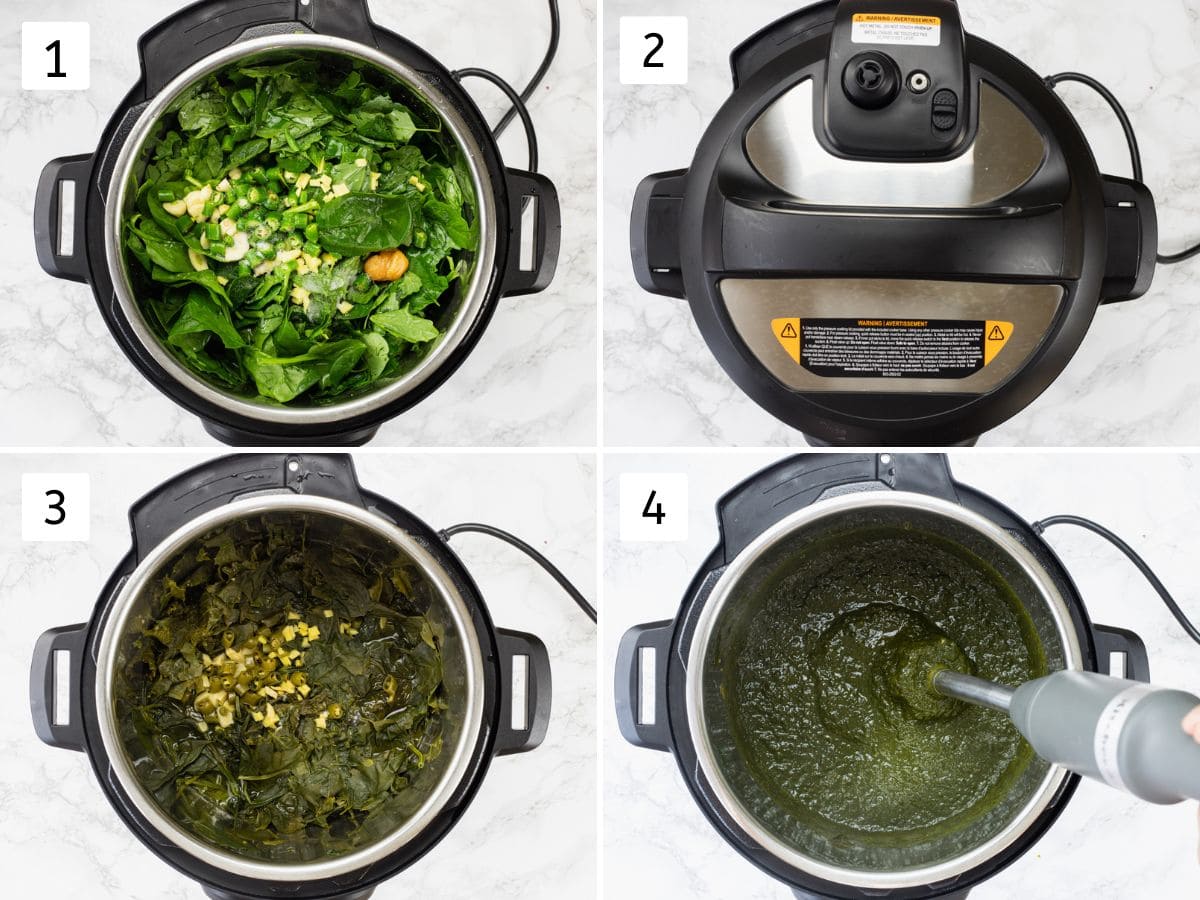
5) Now add makki ka atta and mix.
6) Simmer again (on saute mode in an instant pot or on medium-low heat on a stovetop) for 5 minutes or until the saag thickens. It may splutter a lot, so you can partially cover it while simmering. Also, do stir in between to make sure that it is not sticking to the sides and bottom.
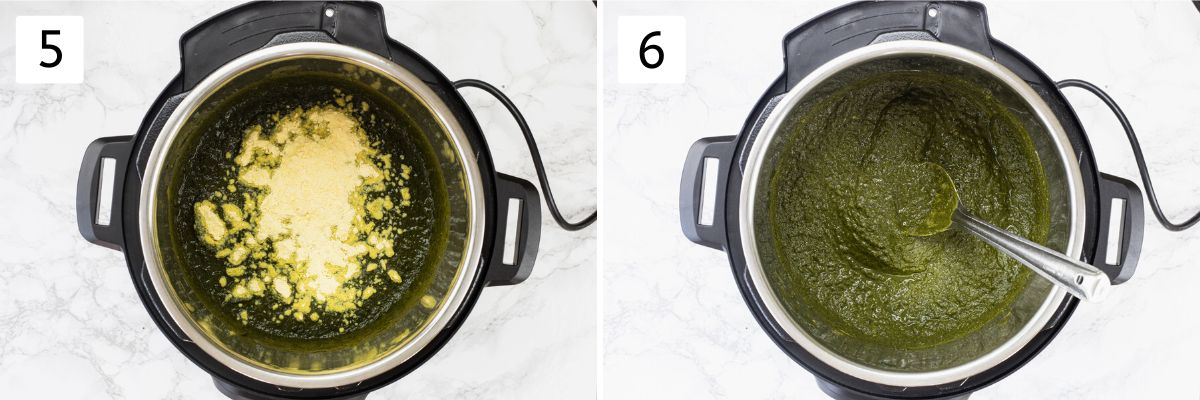
Make Tempering:
1) Heat the ghee in a pan on medium heat. Once hot add cumin seeds and let them sizzle a bit. Add dried red chilies and saute for 30 seconds or until they start to darken. Add hing.
2) Immediately add minced garlic and saute for 40-50 seconds or until the raw smell of garlic goes away.
3) Add onion and sprinkle some salt (just enough for onions because we already added salt in the saag while pressure cooking).
4) Cook until onions turn light brown and soft.
5) Add this mixture into the prepared saag.
6) Mix and It is ready to serve.
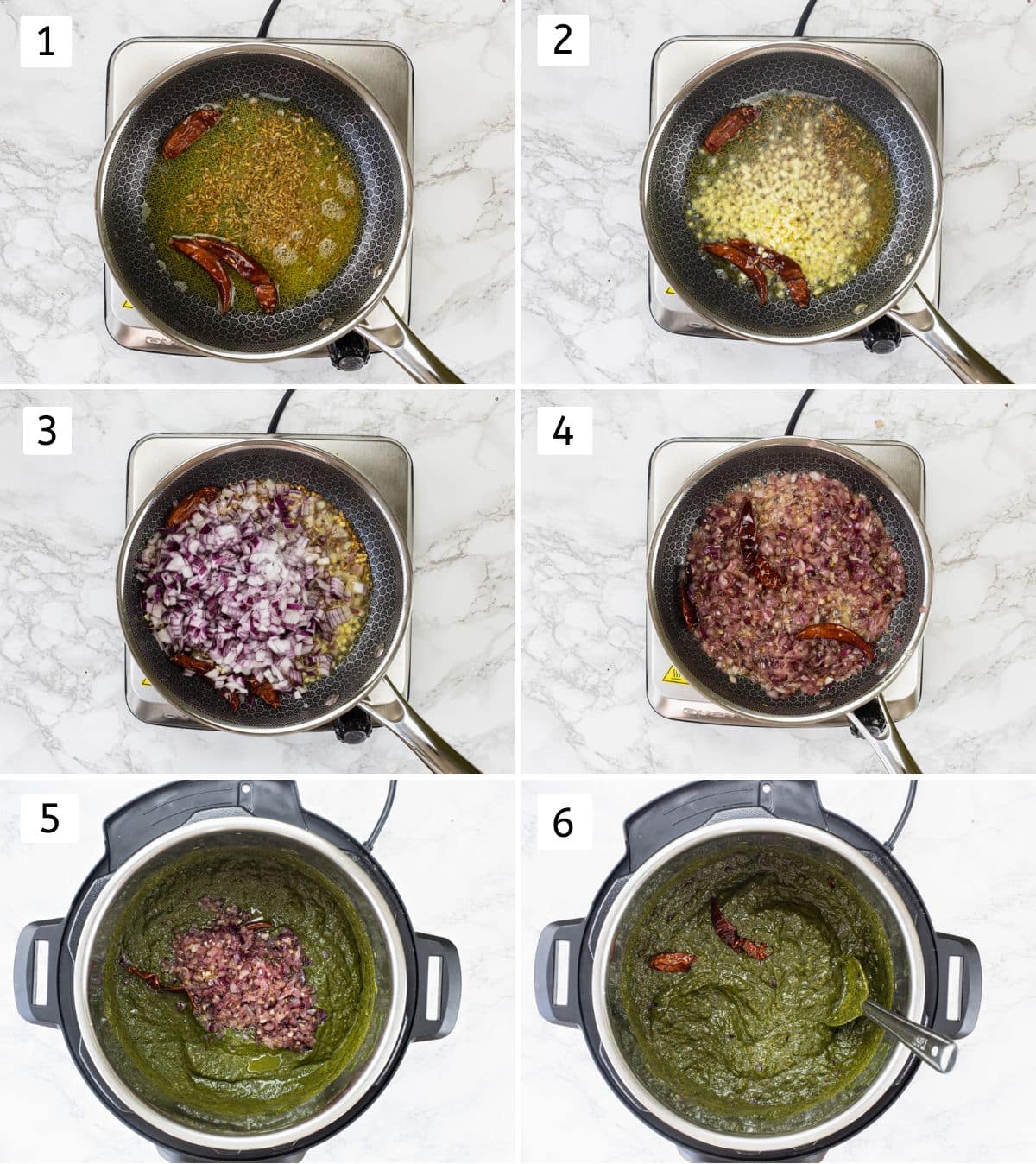
💭 Tips For BEST Sarson Ka Saag
- Prepping greens: You can pluck the leaves earlier in the day or a day before. But always wash them right before cooking otherwise they start to wilt.
- Chopping greens: Because we are using a pressure cooker and hand blender, no need to chop them finely. Even chop the mustard greens roughly and keep spinach and bathua whole. If making the traditional way (using madani to mash the saag) then chop all the greens finely and cook for a little less time. So mashing will be easier if you’ve chopped them earlier.
- Substitute for makki ka atta (maize flour): If you’re in the USA then you can find fine cornmeal easily in the grocery stores, use that. Or you can use besan (chickpea flour) though it will alter the taste slightly.
- My saag turned out bitter, what to do?
- Cook some spinach, puree it, and add it to the prepared saag to reduce the bitterness.
- Add some more makki ka atta and it will tone down the bitterness.
- Color of the sarson ka saag: It has a dark green color (not vibrant green like palak paneer) and it may look unappetizing but trust me it is full of flavors and delicious.
🍽 Serving Ideas For Sarson Ka Saag
- A generous dollop of white butter (makhan) is added to the saag right before serving. Here I have used regular butter as I don’t have access to white butter in the USA.
- Sarson ka saag is usually served with makki ki roti (a flatbread made with maize flour). Though, tastes good with plain paratha or naan.
- Must-have sides with this meal are a piece of jaggery, sliced onions (you can sprinkle some salt and drizzle some lime juice to tone down the sharpness of onions), and pickle.
🥣 Storage Instructions
- In the refrigerator, it stays good for 4-5 days in an airtight container.
- In the freezer, it stays good for up to 3 months. Most of the time, I make the big batch and freeze some in portions for later serving. Just defrost as unusual and reheat in the microwave or stovetop.
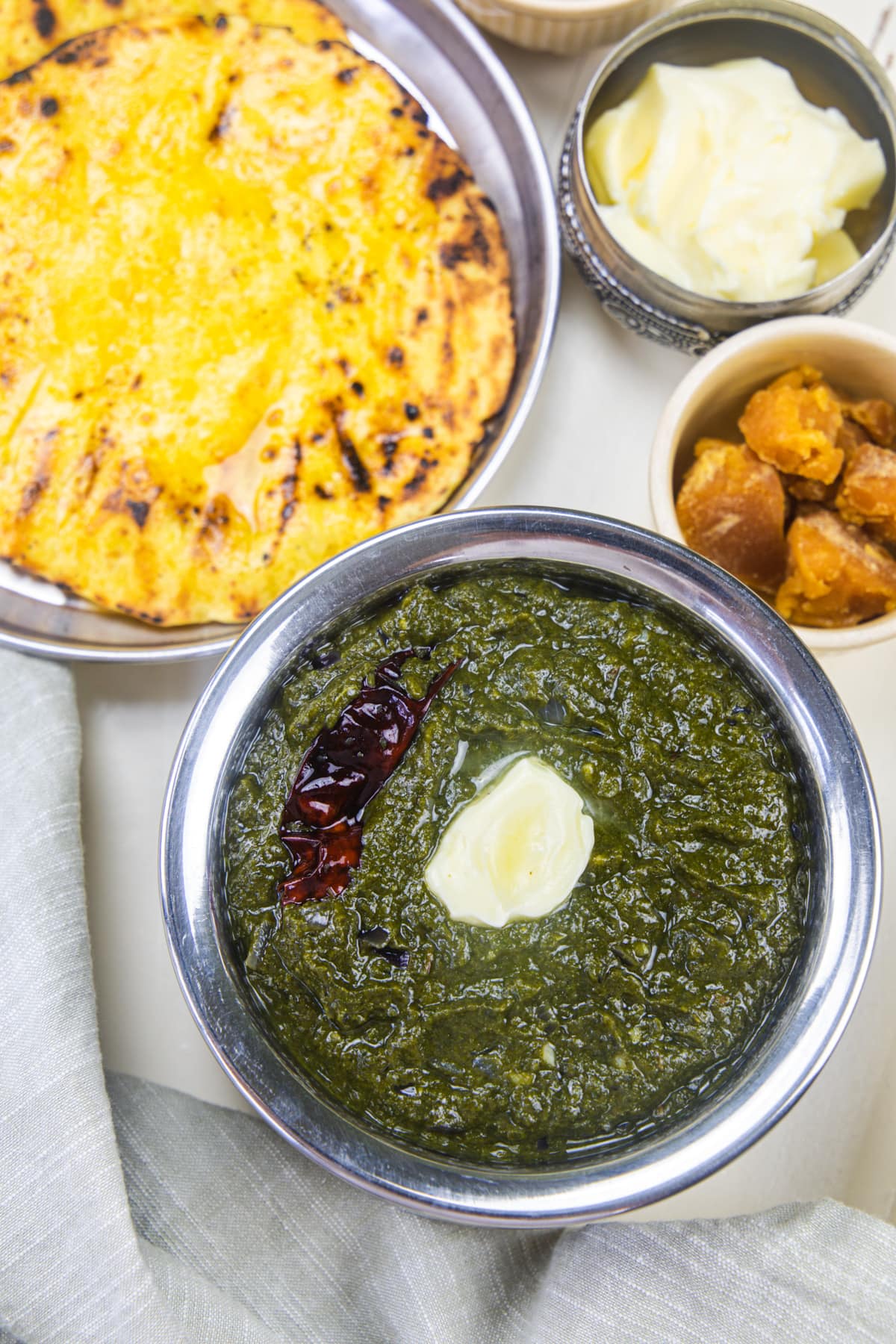
Check Out Similar Recipes
Did you try this sarson ka saag recipe? I’d love to hear about it! Leave a review in the comment section below.
Recipe Card
Sarson Ka Saag Recipe
Ingredients
To Pressure Cook:
- 1 lb Mustard leaves (Sarson) Or broccoli rabe (rapini), (around 500 grams)
- ½ lb Spinach (Palak) (around 250 grams)
- ½ lb Bathua (Chenopodium leaves), (around 250 grams)
- 7-8 cloves Garlic roughly chopped
- 1 inch Ginger roughly chopped
- 5-6 Green chilies roughly chopped
- 1 teaspoon Salt or to taste
- 1 ½ teaspoon Jaggery (Gur)
- ¾ cup Water
Add To Cooked Saag:
- ¼ cup Makki ka atta (maize flour) or fine cornmeal
For Tempering:
- 3-4 tablespoons Ghee (clarified butter)
- 1 teaspoon Cumin seeds
- 3 Dried red chilies
- ½ teaspoon Hing (Asafoetida)
- 4 cloves Garlic minced or finely chopped
- 1 medium Onion , 1 cup chopped
- ¼ teaspoon Salt or to taste
Instructions
- Prep: Remove and discard the tough stems of mustard leaves and keep the leaves in a large bowl of water for around 5-10 minutes and let the dirt, and sand settle at the bottom of the bowl. Then gently without disturbing the water too much remove the leaves, lightly squeeze out the water and chop them roughly. Because we are pressure cooking, no need to chop them finely.
- Similarly, clean the spinach and bathua. Amongst all the greens, bathua will have the maximum amount of dirt sticking to the leaves. So you have to do this cleaning process 2-3 times until the leaves look clean.
- No need to chop spinach and bathua leaves.
- Also, chop the ginger, garlic and green chili into big chunks. Do not chop them finely otherwise pressure cooking makes them flavorless.
- To make saag, take all the greens (mustard leaves, spinach, bathua), chopped ginger, garlic, green chili, salt, and jaggery in a pressure cooker (or instant pot liner). Add water and cover it with a lid.
- Instant pot: Keep the valve to sealing position and cook on manual (high pressure) for 5 minutes. Let the pressure release naturally and wait for the pin to drop.Stovetop pressure cooker: Cook on medium heat for 2 whistles and let the pressure go down by itself.
- Once the pressure is released open the lid. Now using a hand blender, crush them roughly into a coarse texture gravy. If you want then you can make a smooth puree in a blender.
- Now add makki ka atta and mix.
- Simmer again (on saute mode in instant pot or on medium-low heat on stovetop) for 5 minutes or until the saag thickens. It may splutter a lot, so you can partially cover it while simmering. Also, do stir in between to make sure that it is not sticking to the sides and bottom.
- To make Tempering, heat the ghee in a pan on medium heat. Once hot add cumin seeds and let them sizzle a bit.
- Add dried red chilies and saute for 30 seconds or until they start to darken.
- Add hing and immediately add minced garlic and saute for 40-50 seconds or until the raw smell of garlic goes away.
- Add onion and sprinkle some salt (just enough for onions because we already added salt in the saag while pressure cooking). Cook until onions turn light brown and soft.
- Add this mixture into the prepared saag and mix. It is ready to serve.
Notes
- Prepping greens: You can pluck the leaves earlier in the day or a day before. But always wash them right before cooking otherwise they start to wilt.
- Chopping greens: Because we are using a pressure cooker and hand blender, no need to chop them finely. Even chop the mustard greens roughly and keep spinach and bathua whole. If making the traditional way (using madani to mash the saag) then chop all the greens finely and cook for a little less time. So mashing will be easier if you’ve chopped them earlier.
- Substitute for makki ka atta (maize flour): If you’re in the USA then you can find fine cornmeal easily in the grocery stores, use that. Or you can use besan (chickpea flour) though it will alter the taste slightly.
- My saag turned out bitter, what to do?
- Cook some spinach, puree it, and add it to the prepared saag to reduce the bitterness.
- Add some more makki ka atta and it will tone down the bitterness.

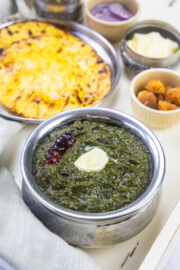
Yvonne
Hi to you ...thank you for sharing the lovely recipe. I first tasted this dish in Delhi and I loved it please can you suggest a different type of leaf that I can use eg spinach because it's difficult to obtain this sarson
Kanan
The closest substitution for mustard leaves (sarso) is broccoli rabe leaves and kale.
Michelle
Looks tasty! Could you provide approximate times for the instant pot?
Kanan
for instant pot, 5 minutes on manual is enough